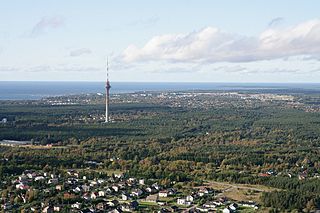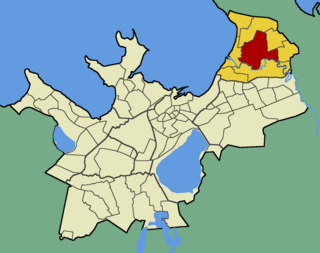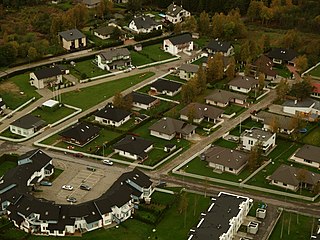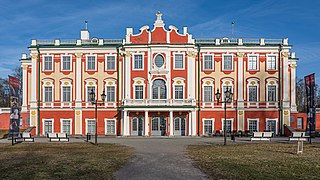| |||||
| Decades: | |||||
|---|---|---|---|---|---|
| See also: | |||||
This article lists events that occurred during 1961 in Estonia .
| |||||
| Decades: | |||||
|---|---|---|---|---|---|
| See also: | |||||
This article lists events that occurred during 1961 in Estonia .
| | This section is empty. You can help by adding to it. (December 2020) |

Tallinn is the capital and most populous city of Estonia. Situated on a bay in north Estonia, on the shore of the Gulf of Finland of the Baltic Sea, Tallinn has a population of about 454,000 and administratively lies in the Harju maakond (county). Tallinn is the main financial, industrial, and cultural centre of Estonia. It is located 187 km (116 mi) northwest of the country's second largest city, Tartu, however only 80 km (50 mi) south of Helsinki, Finland, also 320 km (200 mi) west of Saint Petersburg, Russia, 300 km (190 mi) north of Riga, Latvia, and 380 km (240 mi) east of Stockholm, Sweden. From the 13th century until the first half of the 20th century, Tallinn was known in most of the world by variants of its other historical name Reval.

Tallinn Airport or Lennart Meri Tallinn Airport is the largest airport in Estonia, which serves as a hub for the national airline Nordica, as well as the secondary hub for AirBaltic, cargo airline Airest and LOT Polish Airlines. It was also the home base of the now defunct national airline Estonian Air. Tallinn Airport is open to both domestic and international flights. It is located 2.7 nautical miles southeast of the centre of Tallinn on the eastern shore of Lake Ülemiste. It was formerly known as Ülemiste Airport.

Tartu is the second largest city in Estonia after Tallinn. Tartu has a population of 97,435. It is 186 kilometres southeast of Tallinn and 245 kilometres northeast of Riga, Latvia. Tartu lies on the Emajõgi river, which connects the two largest lakes in Estonia, Lake Võrtsjärv and Lake Peipus. From the 13th century until the end of the 19th century, Tartu was known in most of the world by variants of its historical name Dorpat.

Harju County, is one of the fifteen counties of Estonia. It is situated in Northern Estonia, on the southern coast of the Gulf of Finland, and borders Lääne-Viru County to the east, Järva County to the southeast, Rapla County to the south, and Lääne County to the southwest. The capital and largest city of Estonia, Tallinn, is situated in Harju County. Harju County is the largest county in Estonia in terms of population, as almost half (45%) of the Estonia's population lives in Harju County.

The MS Estonia was a cruiseferry built in 1980 for the Finnish company Rederi Ab Sally by Meyer Werft, in Papenburg, West Germany. She was employed on ferry routes between Finland and Sweden by various companies until 1993, when she was sold to Nordström & Thulin for use on Estline's Tallinn–Stockholm route. The ship's sinking on 28 September 1994, in the Baltic Sea between Sweden, Finland and Estonia, was one of the worst peacetime maritime disasters of the 20th century, claiming 852 lives.

Tallinn TV Tower is a free-standing structure with an observation deck, built to provide better telecommunication services for the 1980 Moscow Summer Olympics regatta event. It is located near the suburb Pirita, six km north-east of the Tallinn city center. With its 313 m (1030.2 ft), the TV tower is the tallest nonbuilding structure in Tallinn. The tower was officially opened on 11 July 1980. The viewing platform at a height of 170 metres was open to the public until 26 November 2007, when it was closed for renovation. The tower began receiving visitors again on 5 April 2012. The building is administered by the public company Levira and is a member of the World Federation of Great Towers.

Edgar Savisaar was an Estonian politician, one of the founding members of Popular Front of Estonia and the Centre Party. He served as the acting Prime Minister of Estonia, Minister of the Interior, Minister of Economic Affairs and Communications, and twice mayor of Tallinn.

Konstantin Päts was an Estonian statesman and the country's president in 1938–1940. Päts was one of the most influential politicians of the independent democratic Republic of Estonia, and during the two decades prior to World War II he also served five times as the country's prime minister. After the 16–17 June 1940 Soviet invasion and occupation of Estonia, President Päts remained formally in office for over a month, until he was forced to resign, imprisoned by the new Stalinist regime, and deported to the USSR, where he died in 1956.

Paldiski is a town and Baltic Sea port situated on the Pakri Peninsula of northwestern Estonia. Since 2017, it's the administrative centre of Lääne-Harju Parish of Harju County. Previously a village of Estonia-Swedes known by the historical name Rågervik, it was extended into a Russian naval base in the 18th century. The Russian authorities renamed it Балтийский Порт in 1762. In written Estonian, the name was spelled Baltiski until 1933, when the phonetically spelled version Paldiski became official.

Jaan Kaplinski was an Estonian poet, philosopher, politician, and culture critic, known for his focus on global issues and support for left-wing/liberal thinking. He was influenced by Eastern philosophical schools.
The possible elm cultivar Ulmus 'Jalaica' hails from the Baltic states. Living specimens are grown in the arboretum at the National Botanic Garden of Latvia, Salaspils, introduced in 1998 from the Tallinn Botanic Garden and the plantarium OPU Tallinn, Estonia. It was assumed the word 'Jalaica' was the name given the cultivar, but it has since emerged that the word simply means 'Elm' in Estonian, and the trees donated may not in fact be cultivars, although of rather unusual appearance.

Pirita is one of the eight administrative districts of Tallinn, the capital of Estonia.

Kose is a subdistrict of the district of Pirita in Tallinn, the capital of Estonia. It has a population of 3,351.

Kloostrimetsa is a subdistrict in the district of Pirita, Tallinn, the capital of Estonia. It's located north of the Pirita River and is mostly covered by the park forest Kloostrimets. Kloostrimetsa has a population of 80.

Lepiku is a subdistrict in the district of Pirita, Tallinn, the capital of Estonia. It has a population of 1,523.

Tallinn Botanic Garden, is a botanical garden in Tallinn, Estonia. It is located on the right bank of the Pirita River, in the Kloostrimetsa forest in Pirita district. With an area of 123 ha, it is the largest in Estonia.

Kadriorg Palace is an 18th-century Petrine Baroque palace in Kadriorg, Tallinn, the capital of Estonia. Both the Estonian and the German name for the palace means "Catherine's valley". It was built in 1718–1725 to Nicola Michetti's designs by Gaetano Chiaveri and Mikhail Zemtsov. The palace currently houses the Kadriorg Art Museum, a branch of the Art Museum of Estonia, displaying foreign art from the 16th to 20th centuries. The building of the Kumu branch of the museum, showing Estonian art from the 18th century onwards is located nearby in the Kadriorg Park.
Viidu is a village in Saaremaa Parish, Saare County in western Estonia.

University of Tartu Botanical Garden, is a botanical garden in Tartu, Estonia. It belongs to the University of Tartu.
The following is a timeline of the history of the city of Tallinn, Estonia.